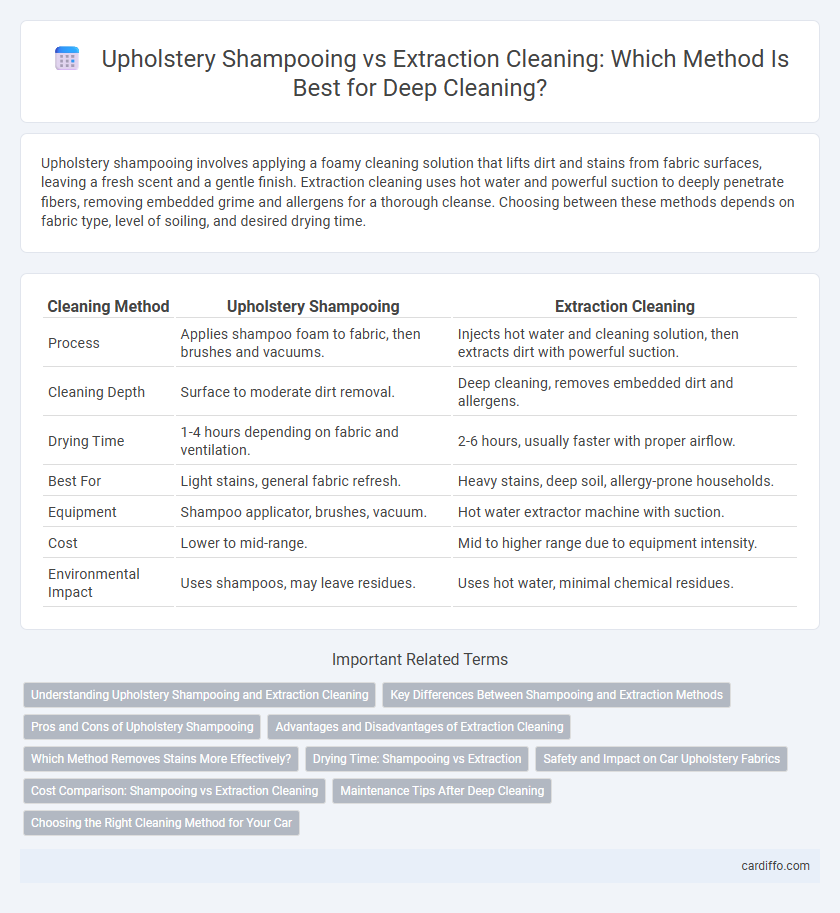Upholstery shampooing involves applying a foamy cleaning solution that lifts dirt and stains from fabric surfaces, leaving a fresh scent and a gentle finish. Extraction cleaning uses hot water and powerful suction to deeply penetrate fibers, removing embedded grime and allergens for a thorough cleanse. Choosing between these methods depends on fabric type, level of soiling, and desired drying time.
Table of Comparison
| Cleaning Method | Upholstery Shampooing | Extraction Cleaning |
|---|---|---|
| Process | Applies shampoo foam to fabric, then brushes and vacuums. | Injects hot water and cleaning solution, then extracts dirt with powerful suction. |
| Cleaning Depth | Surface to moderate dirt removal. | Deep cleaning, removes embedded dirt and allergens. |
| Drying Time | 1-4 hours depending on fabric and ventilation. | 2-6 hours, usually faster with proper airflow. |
| Best For | Light stains, general fabric refresh. | Heavy stains, deep soil, allergy-prone households. |
| Equipment | Shampoo applicator, brushes, vacuum. | Hot water extractor machine with suction. |
| Cost | Lower to mid-range. | Mid to higher range due to equipment intensity. |
| Environmental Impact | Uses shampoos, may leave residues. | Uses hot water, minimal chemical residues. |
Understanding Upholstery Shampooing and Extraction Cleaning
Upholstery shampooing involves applying a foamy detergent that penetrates fabric fibers to lift dirt and stains, making it ideal for delicate materials requiring gentle treatment. Extraction cleaning, also known as hot water extraction or steam cleaning, uses high-pressure hot water combined with powerful suction to deeply clean and remove embedded soil and allergens from upholstery. Both methods aim to restore fabric cleanliness but differ in technique, drying time, and suitability for various upholstery types.
Key Differences Between Shampooing and Extraction Methods
Upholstery shampooing involves applying a foamy detergent to fabric surfaces and manually scrubbing to lift dirt and stains, which then requires thorough drying to prevent mold growth. Extraction cleaning, also known as hot water extraction or steam cleaning, uses high-pressure hot water combined with a vacuum to deeply penetrate upholstery fibers, removing dirt, allergens, and bacteria more effectively. The key differences lie in the cleaning depth, drying time, and residue left behind, with extraction offering a deeper clean and faster dry times compared to the more surface-level, residue-prone shampooing method.
Pros and Cons of Upholstery Shampooing
Upholstery shampooing deep-cleans fabric by applying foamy detergent and scrubbing to lift dirt and stains, offering effective spot treatment for heavily soiled areas. However, it requires longer drying times and can leave residue that attracts dirt if not thoroughly rinsed, potentially causing fabric wear over time. This method is cost-effective for superficial cleaning but less suitable for delicate materials or heavy contaminants compared to extraction cleaning.
Advantages and Disadvantages of Extraction Cleaning
Extraction cleaning effectively removes deep-seated dirt and allergens from upholstery by using hot water combined with strong suction, enhancing overall fabric hygiene. Its main advantage is the thorough cleaning and faster drying time compared to shampooing, which often leaves residues and longer drying periods. However, extraction cleaning may be less effective on heavily soiled fabrics or stains that require specialized treatments, and the process demands professional equipment for optimal results.
Which Method Removes Stains More Effectively?
Extraction cleaning removes stains more effectively than upholstery shampooing by injecting hot water and cleaning solution deep into fabric fibers, then extracting dirt and grime with a powerful vacuum. Upholstery shampooing uses foam or liquid detergents applied to the surface, which may be less effective at removing deep or set-in stains. Extraction cleaning's ability to penetrate and extract contaminants leads to more thorough stain removal and cleaner upholstery.
Drying Time: Shampooing vs Extraction
Upholstery shampooing typically involves applying a foamy solution that requires longer drying times, often up to 12-24 hours, as moisture is absorbed into the fabric and padding. Extraction cleaning uses hot water or steam to deep-clean fibers while simultaneously removing dirt and excess moisture, resulting in faster drying times usually within 2-6 hours. Choosing extraction cleaning over shampooing significantly reduces downtime and risk of mold or mildew development due to quicker moisture evaporation.
Safety and Impact on Car Upholstery Fabrics
Upholstery shampooing uses foam-based cleaners that can leave residue and moisture, potentially causing mold growth and fabric damage if not properly dried. Extraction cleaning employs hot water extraction combined with strong suction to remove deep-seated dirt and allergens, minimizing moisture retention and reducing the risk of fabric deterioration. Choosing extraction cleaning enhances fabric safety and longevity by effectively cleansing without compromising the upholstery's structural integrity.
Cost Comparison: Shampooing vs Extraction Cleaning
Upholstery shampooing typically costs between $50 and $100 per room, making it a more budget-friendly option for routine cleaning. Extraction cleaning, while slightly pricier, ranging from $80 to $150 per room, offers deeper stain removal and longer-lasting results. Choosing between shampooing and extraction cleaning often depends on the level of soil and budget considerations.
Maintenance Tips After Deep Cleaning
To maintain upholstery after shampooing or extraction cleaning, regularly vacuum the surface to prevent dirt buildup and prolong fabric life. Avoid using harsh chemicals or soaking the upholstery with water to reduce the risk of mold and mildew growth. Promptly address spills with a clean, damp cloth and schedule professional deep cleaning every 12 to 18 months for optimal fabric preservation.
Choosing the Right Cleaning Method for Your Car
Upholstery shampooing effectively removes surface dirt and stains from car seats, utilizing foam-based cleaners that penetrate fabric fibers for a thorough clean. Extraction cleaning, often called steam cleaning, uses high-pressure water and vacuum suction to deeply extract embedded dirt, allergens, and moisture from upholstery, ensuring a more comprehensive refresh. Choosing between shampooing and extraction depends on fabric type, degree of soiling, and drying time preferences, with extraction preferred for heavy stains and deep cleaning needs in modern car interiors.
Upholstery Shampooing vs Extraction Cleaning Infographic

 cardiffo.com
cardiffo.com